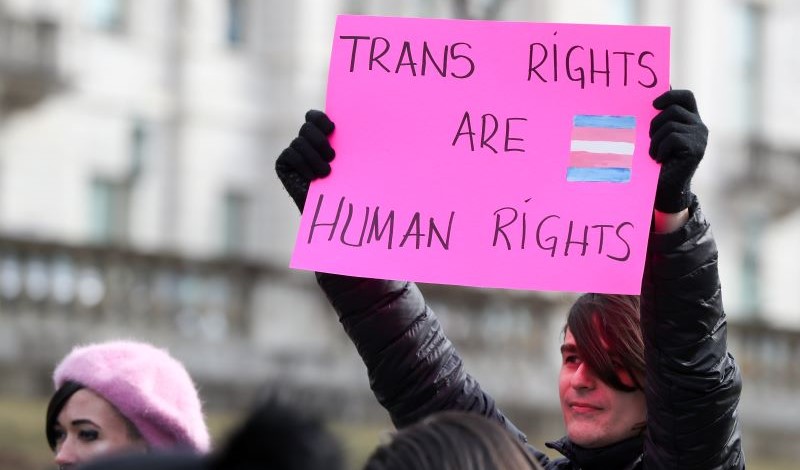
The Trump Administration’s definition of biological sex does not accurately reflect modern science.
The Trump Administration’s ongoing efforts to erase the existence of transgender people are often defended in the name of the so-called “common sense” of “biological sex.” For instance, in Executive Order 14,168, President Donald J. Trump purports to establish that the federal government will “only recognize two sexes, male and female,” and sex is defined as “an individual’s immutable biological classification as either male or female.” In so doing, anti-transgender policymakers make explicit appeal to what the newly confirmed Secretary of the Department of Health and Human Services Robert F. Kennedy, Jr. referred to as the “common sense” of biological sex.
These anti-transgender policies misapprehend and misconstrue the biological truths of sex. Even in terms of biology alone, sex is not the product of one single gene, hormone, chromosome, or genital. Rather, a person’s sex can be influenced by a host of factors, and how each person’s sex is constituted will vary depending on the variance and valence of these different factors. Voters, lawmakers, and agency officials seeking to regulate transgender people must begin to appreciate this beautiful nuance, rather than be afraid of it.
Many skeptics of the existence of transgender people offer reductive, bioessentialist explanations for sex and argue that it is solely a product of our genes and chromosomes, which, in turn, lead to dimorphic reproductive systems and genitalia. They argue, in essence, that if you have XX chromosomes, then you will develop ovaries, a uterus, a vagina, and eggs, and will be female. Conversely, if you have XY chromosomes, you will develop testicles, a penis, and sperm, and will be male. It is these characteristics, they argue, that dictate one’s “biological sex.”
Truth be told, the many laws and regulations attempting to deny the existence of transgender people often define sex differently themselves. For example, President Trump’s first anti-trans executive order defines male and female with reference to the size of the reproductive cell each produces. By comparison, Florida’s transgender bathroom ban defines sex with reference to an individual’s “specific reproductive role, as indicated by the person’s sex chromosomes, naturally occurring sex hormones, and internal and external genitalia present at birth,” while elsewhere also referencing reproductive cells.
This divergence itself underscores that even in terms of biology, there is a lot to pick and choose from. Nevertheless, with different degrees of emphasis, anti-trans advocates claim that the biological truth is self-evident and that everyone’s bits and pieces always align.
Although the story of consistent, unidirectional development from chromosomes to gametes and external genitalia may—in broad strokes—be true for many individuals, it is not true for all. It also elides the complexity of biological development even in the stereotypical case. Evolutionary biologist Joan Roughgarden explains that “the fundamental mistake made in developmental biology is privileging a master controlling narrative for genes.” This is, at its core, the mistake made by anti-trans advocates with their overemphasis on external genitalia as an expression of chromosomes and genes. But in reality, as individual gametes—the egg and sperm—and then as a zygote, embryo, fetus, child, and indeed as adults, our bodies and identities are “socialized and chemically experienced, the proud graduate of a biological education from many organic teachers.” Our sexed identities are subjected to complex biochemical negotiation from the outset and at several points thereafter. And the sexual development process, rather than being characterized as a one-way path of inevitability toward a particular dimorphic sex, is characterized at several turns by indifference or what biologist Anne Fausto-Sterling refers to as “bipotentiality”—the potential to develop in either a stereotypically male or female direction, with those turns not always going in the same direction.
Take the Y chromosome, for instance. As Roughgarden explains, a gene on the Y chromosome, called the SRY gene, “redirects and accelerates gonadal differentiation in the direction of a testis; in its absence, the gonad differentiates more slowly into an ovary.” For this reason, the Y chromosome—and the SRY gene—are often given exclusive credit for dictating sex differentiation. But gonads do not develop until “after some sex differences are already determined, so SRY doesn’t fully control sex differentiation; it can only influence gendered presentation to some degree.” Indeed, as Roughgarden continues, “the gonads can develop at least partially into testes on their own, even without the coaxing by SRY.” As such, “SRY is only one player in the germ-cell-to-gonad negotiation, with the role, as a genetic lobbyist, of coaxing the gonad in the male direction. SRY doesn’t unilaterally control sex determination, because sex is already determined before SRY is expressed.”
Moreover, even after the intervention of the SRY gene, several other genes influence the indifferent or bipotential gonad tissue in the direction of testes. Similarly, other genes intervene to influence the gonad tissue to develop in a female direction. Fausto-Sterling has argued that “the process runs more like a parliament than an autocratic dictator.”
Expanding one’s frame beyond the Y chromosome, important as it may be, Fausto-Sterling explains:
A newborn is a multilayered sexual creature, the result of having a chromosomal sex, a fetal gonadal sex, fetal hormonal sex, a fetal internal reproductive sex, a brain sex … an external genital sex, and starting from the moment the child leaves the womb, a developing body image and social gender fortification.
From there, as Fausto-Sterling further explains, a child will develop a “juvenile gender identity,” and with the onset of puberty, an individual will experience pubertal hormonal sex followed by pubertal morphological sex. She adds that “all of these different sexes and identities in turn converge to produce adult gender identity, the sense of self as an adult male or an adult female”—or, I would add, another gender altogether—and “each of these layers can, potentially, develop independently of one another.”
Taking these developmental components in turn and moving from chromosomal sex and fetal gonadal sex, on the one hand, to fetal hormonal sex and internal reproductive sex, on the other, we see that the bipotentiality persists. The accessory ducts “needed to transport sperm or eggs, to sustain fetal development, and, generally, to carry out the nitty gritty of sexual production” also start out as a bipotential structure, but hormones produced in the fetus by the developing testes or ovaries select which ducts persist and which do not, leading to the development of the vas deferens, epididymis, and seminal vesical or fallopian tubes.
Similarly with respect to external genital sex, Fausto-Sterling details how “the fetus starts out indifferent, or bipotential, with regard to the external bits—penis, clitoris, scrotum, and vaginal folds”—but under the influence of fetal hormones begins to differentiate.
Then there is the brain.
Certain parts of our brains are sexually different, and some studies have suggested that in transgender people one of these areas—the central division of the bed nucleus of the stria terminalis—is consistent with the individual’s gender identity and not the individual’s sex assigned at birth, suggesting that this area of the brain influences gender identity. But, at the same time, as Fausto-Sterling notes, “brains and nervous systems are plastic. Overall anatomy—as well as the less visible physical connections among nerve cells, target organs, and the brain—change not only just after birth but even into the adult years.”
All told, even in terms of biology alone—which, again, it is impossible to isolate truly from environmental and social influences—the story is incredibly complicated. Given the many sexed components of our bodies and the complexity of their development, it should come as little surprise that humans are sexually diverse and that the reductionist binary, though perhaps historically a useful shorthand, is just that—a generalization that erases many important details of our development and, more importantly, many important people who beautifully complicate the standard script.
As put by Roughgarden, “all species have genetic diversity—their biological rainbow.” Humans are no exception. Indeed, even though taxonomies and categories are useful tools for understanding themes or trends, “in biology, nature abhors a category.” Primatologist Frans de Waal states in his study of gender in apes that “nature loves variety. Unfortunately, society hates it.” This diversity extends to sexuality and sex. Similarly, biologist Bruce Bagemihl explains in his study on the breathtaking scope of sexual diversity among species that “the world is, indeed, teeming with homosexual, bisexual, and transgender creatures of every stripe and feather.” Bagemihl summarizes how “many creatures are ‘transgender’ crossing or combining characteristics of both males and females in their appearance or behavior. Amid this incredible variety of different patterns, one thing is certain: the animal kingdom is most definitely not just heterosexual.”
Collegiate athlete and transgender activist Schuyler Bailar explains that “recognizing the complexity of biological sex does not negate or erase biology. Quite the opposite is true: defining sex by absolute categories of ‘male’ and ‘female’ erases biology … Biological sex is very real—it just isn’t as simple or binary as people make it out to be.” And the law, rather than trying to gloss over or quash this diversity, should make space for it.
Make no mistake, even in terms of biology, sex is very complex, and there is still much to learn about sex and gender. As bioethicist Florence Ashley charmingly contends, “anyone who claims to have a clear or complete understanding of gender is a liar, liar pants on fire.” As such, it is critical to approach discussions of gender and sex—and therefore the regulatory regimes we seek to impose on transgender people—with a degree of humility and with a modicum of caution.
This lack of a perfect, universal understanding will make many of us uncomfortable. But as developmental and clinical psychologist Diane Ehrensaft underscores aptly, “we have to be humble enough to admit to knowing much more about the ‘what’ of gender (how each of us puts our gender together, how it looks in a particular culture, and so forth) than the ‘why’ of gender (the actual determinants that … cause only some people to be transgender).”
At the end of the day, having a perfect understanding of the “why” of sex and gender is not that necessary for us to make political and legal decisions about how we treat each other. Transgender historian Susan Stryker explains that it is “more important to acknowledge that some people experience gender differently from how most do than to say why people experience gender differently from how most do.” Optimistically, political scientist Joanna Wuest notes that “it is fortunate that achieving meaningful equality does not depend much at all on ‘knowing’ the true nature of desire or identity … But while thwarting political foes oftentimes does call for evidence of what sexual orientation and gender identity are not—that is, injurious or infectious—we need not pin down their elusive origins and ontology to be politically or personally liberated.” As a society, we are at an inflection point with respect to how we will treat one another. We do not know everything about sex. But we do have the power to choose decency over demagoguery.




